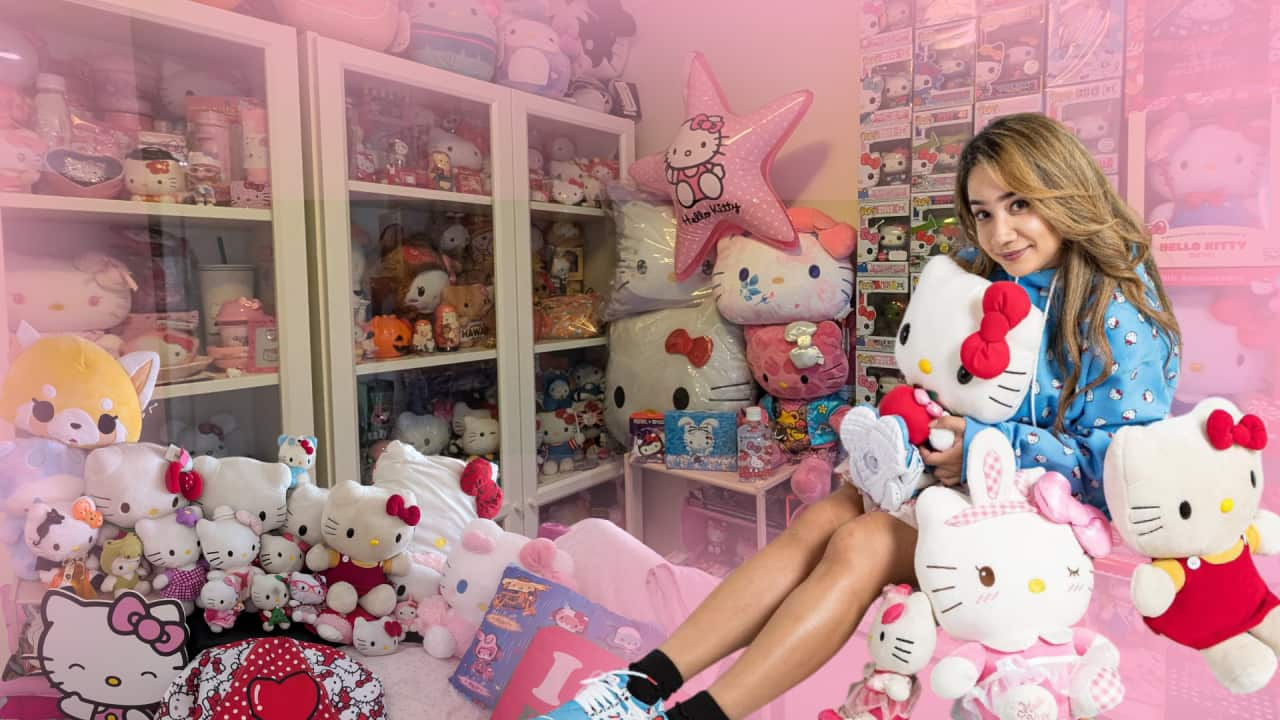Key Points
- Hello Kitty is celebrating its 50th anniversary on 1 November.
- The Japanese pop culture icon has attracted fans of all ages across the world.
- It's become a symbol of Japanese 'kawaii' (cute) culture and soft power, an anthropologist says.
Victoria Kyriakopoulos was nine years old when Hello Kitty entered her life.
Now, 24 years later, she's the proud owner of a massive memorabilia collection comprising thousands of figurines, items of clothing and other merchandise.
"I try not to keep track (of the the collection's worth), but it's probably enough for a house deposit," she told SBS Japanese.

Victoria's collection of Hello Kitty memorabilia numbers in the thousands. Credit: SBS
The brand's net worth is estimated to be over $120 billion.
Originally marketed towards preteen girls in Japan, Hello Kitty today captivates fans of all ages as a symbol of Japanese kawaii (cute) culture.
Kyriakopoulos was born in Adelaide but first met Hello Kitty in the Philippines, her mother’s country, and was instantly spellbound.
"Everything was cute, everything was pink," she said.
While Victoria first thought her obsession would be just a phase, the character continued to charm her well into adulthood.
My reason for liking Hello Kitty has evolved, just like Hello Kitty has.Victoria Kyriakopoulos
"The thing that really excites me about Hello Kitty is going overseas and finding items. I like to find items that I wouldn’t normally find in Australia," she said.
Humble beginnings
Hello Kitty first appeared on a coin purse in 1974.
Since those humble beginnings, she has appeared on nearly every type of merchandise imaginable, from stationery and clothing to snacks and electronics.

Hello Kitty first appeared on a coin purse in 1974. Credit: SBS
"You can never buy the whole collection of Hello Kitty, she is everywhere. And that’s the part of the thrill for me," Kyriakopoulos said.
The Melbourne-based travel writer is counting the days till 1 November, when Hello Kitty officially turns 50.
She will be flying to Japan for the official birthday celebration at Sanrio Puroland, a theme park devoted to Hello Kity and other Sanrio characters.
"For her (Hello Kitty) to last 50 years, it is incredible," she said.
'Borderless appeal'
Nobuko Burnfield, a Sydney-based former animator for Sanrio, attributed Hello Kitty's success to the "innocence and simplicity" of her design.

Former Sanrio staff member Naoko Madokoro with Hello Kitty products she designed (left), and former Sanrio animator Nobuko Burnfield (right). Credit: Naoko Madokoro/Nobuko Burnfield
Naoko Madokoro, another former Sanrio staff member who lives in Japan, added that because Hello Kitty was designed without a mouth, people easily empathise with her.
"When we feel happy, Kitty shares in that joy, and when we're sad, she comforts us. She’s always there, providing a sense of companionship," she said.

Hello Kitty has evolved over the years. Credit: PR Times/Sanrio
An icon of 'Cool Japan'
Dr Christine Yano is a professor of anthropology at the University of Hawaii and the author of Pink Globalisation: Hello Kitty's Trek across the Pacific.
She said she is "stunned" by the amount of media play Hello Kitty has received over the years.
"This is something beyond what Sanrio created ... Whether you call it nostalgia, or soft power for Japan, I am stunned and surprised," she said.
According to Yano, Hello Kitty emerged amid the rise of 'girl culture' as a consumer phenomenon.
"(This is) a world that Sanrio developed and exploited," she said.

Dr Christine Yano is the author of Pink Globalisation: Hello Kitty's Trek across the Pacific. Credit: Dr Christine Yano
As an example, she cited the appointment of Sanrio's icon as the 'Ambassador of Tourism' to Taiwan and Korea in 2008.
"This 50th anniversary is very significant, not just for the longevity of the product, but (for) something this product is touching in people," she said.
At a time of unrest and uncertainty, "it speaks to certain kinds of need, even after 50 years."
"Those needs have changed (over the years) but there seems to be always a kind of spot for something like Hello Kitty. As the public has evolved, Hello Kitty has evolved, Japan and Sanrio have evolved."
For Victoria, the anniversary is a "once in a lifetime opportunity" for connecting with others who share the same passion.
Listen to SBS Japanese Audio on Tue, Thu and Fri from 1pm on SBS 3.



